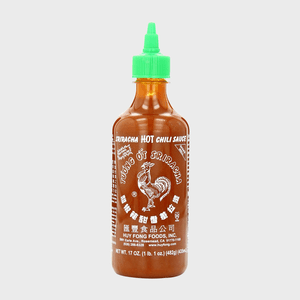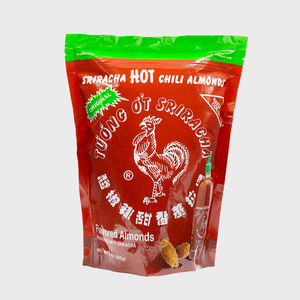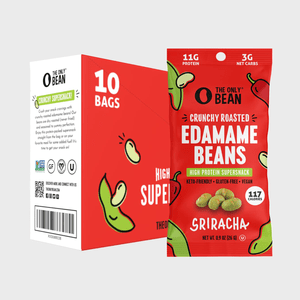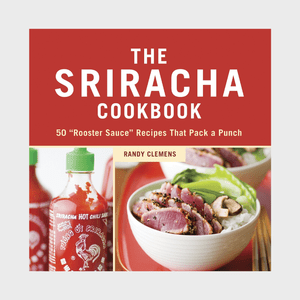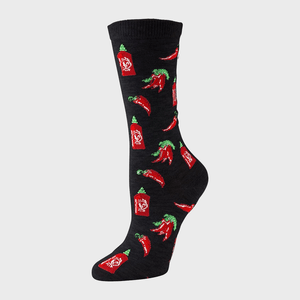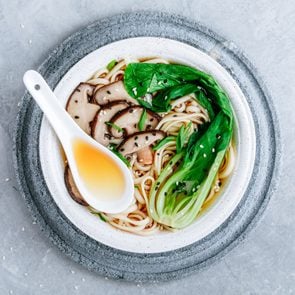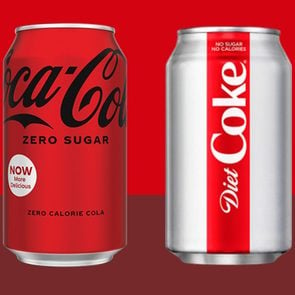What Is Sriracha, Exactly?
Updated: Jul. 04, 2023
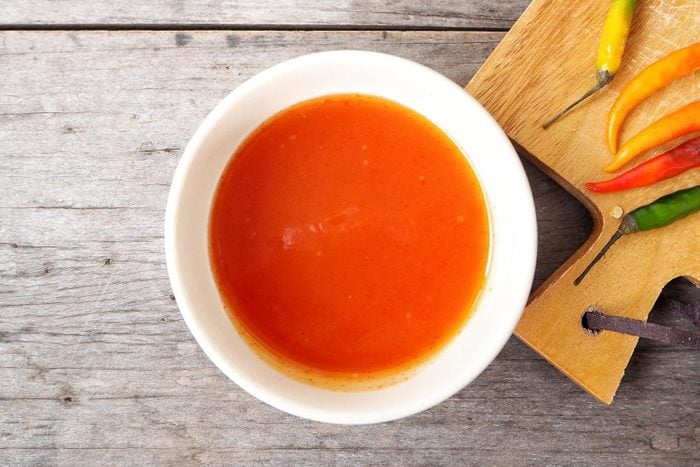
We'll splash sriracha on, well, just about everything. We unpack exactly what makes this spicy sauce so darn good.
In the past decade or so, sriracha (pronounced see-ROTCH-ah) went from being a specialty condiment to a bona fide phenomenon. There are sriracha-flavored snack foods, sriracha-centric cookbooks—you can even buy sriracha socks! Sriracha is a new American classic that has a place at the table come breakfast (try it next time you make scrambled eggs!), lunch (squirt it on your sushi for a different kind of burn than wasabi) and dinner (it’s beautiful on big, juicy burgers with crispy bacon and melted American cheese). But what is sriracha, exactly, and what makes it so irresistible? For more food trivia (like what is margarine?), don’t forget to check out these other fun food facts.
So, what is sriracha?
Sriracha is a thick, tangy-sweet chili pepper sauce with a strong kick of garlic. Though it is spicy, its flavor is much more layered and complex than common hot sauces like Tabasco, which taste of heat and vinegar. It’s also far thicker, with a consistency more similar to ketchup or tomato sauce than watery American-style hot sauces, which are typically made by puréeing peppers in vinegar, then straining out the solid materials.
The recipe for sriracha was developed more than 80 years ago in Si Racha, a city on Thailand’s east coast. The first commercial variety, Sriraja Panich, became one of the most popular condiments in Southeast Asia, but it was not easy to find in America and was very expensive to import.
In 1980, a Vietnamese immigrant named David Tran decided to start producing his own version of sriracha in America, opening Huy Fong Foods in Irwindale, California. To this day it remains the most popular brand of sriracha, and its packaging is nothing short of iconic: a clear plastic bottle that shows off the vividly red hot sauce, a green twist-to-open squirt cap and a white rooster logo printed on the front that gives Huy Fong Sriracha its nickname, “Rooster Sauce.”
From the get-go, Huy Fong Sriracha was massively popular as a specialty ingredient in Asian American businesses, restaurants and supermarkets, and highly beloved by chefs, foodies and restaurant insiders. Its popularity exploded in 2009 when Bon Appetit named it “Best Ingredient of the Year,” and once it became a bona fide phenomenon, imitators soon followed. However, Huy Fong Rooster Sauce remains the most popular sriracha on the market; its factory produces 3,000 bottles every hour, 24 hours a day, six days a week. That’s about 20 million bottles of sriracha a year!
Sriracha ingredients
What is sriracha made of? The list of sriracha ingredients can vary by brand or recipe, but most are similar to, if not exactly the same as, the ones used in Huy Fong’s iconic Rooster Sauce. According to the company, its Sriracha ingredients are chilis, sugar, salt, garlic, distilled vinegar, potassium sorbate, sodium bisulfite and xanthan gum.
Chili peppers
The primary ingredient in Sriracha is red jalapeño peppers, which are puréed raw, seeds and all, into a thick paste with distilled vinegar.
Vinegar
In addition to adding flavor, highly acidic distilled vinegar helps break down and “cook” the raw peppers and thin them out into a sauce. It also acts as a preservative.
Garlic
A large quantity of garlic gives Sriracha its signature flavor and adds body to the sauce.
Sugar
Sriracha isn’t noticeably sweet, but it does contain sugar, which helps balance out the heat from the chili peppers, making the sriracha less spicy. A bottle of sriracha contains roughly the same amount of sugar as a bottle of ketchup (speaking of which, does ketchup really need to be refrigerated?).
Salt
Salt is added as both a flavoring and a preservative.
Potassium sorbate
Potassium sorbate is a food-grade chemical additive that prevents bacteria and mold growth. In small amounts, this natural preservative is safe for everyday use.
Sodium bisulfite
Sodium bisulfite is a salt-based chemical compound used in foods to preserve freshness and color.
Xanthan gum
A common food additive that’s also commonly used in gluten-free baking, xanthan gum is a thickening agent that gives sriracha its spreadable, ketchup-like texture.
Is sriracha really spicy?
Even though its primary ingredient is red jalapeño peppers, when compared with other hot sauces, sriracha isn’t all that spicy. According to the Scoville scale (a unit of measure for the level of heat in chilis), sriracha measures only about 2,200 Scoville Heat Units (SHU); straight red jalapeño peppers, meanwhile, range between 2,500 and 8,000 SHU.
Though it is undoubtedly spicy, sriracha is not as hot as Tabasco sauce, which measures 2,500 SHU, or Choulula hot sauce, which clocks in at 3,600 SHU. However, sriracha is hotter than most popular cayenne pepper hot sauces like Crystal (800 SHU), Texas Pete (450 SHU) and Frank’s Red Hot (450 SHU).
Is sriracha gluten-free?
The recipe for sriracha is naturally gluten-free. Though Huy Fong’s Sriracha Rooster Sauce is not specifically labeled gluten-free, it does not have any ingredients that contain gluten and is considered safe for people with celiac disease or gluten-intolerance symptoms. It’s unlikely that any other brands of sriracha contain gluten, but to be safe, always read the ingredient label before purchasing.
Is sriracha vegan?
Yes! If you’re vegan or thinking of becoming vegan, you can still enjoy sriracha, as it does not contain any animal byproducts.
How to use sriracha
What is sriracha good for in the kitchen? Just about everything! If you’re just getting to know it as a condiment, think of it like a fiery, chili-pepper-based ketchup. To mellow out the heat, try mixing it with a bit of mayonnaise and use it as a spread for sandwiches, or a dipping sauce for fast-food fries. Sriracha is an Asian condiment, but it plays nicely with umami-rich food from all over the world.
As an ingredient, you can stir small amounts into soups, stews and sauces to add gentle notes of garlic and chilis, without worrying about adding too much spiciness. It’s a staple with Vietnamese pho! Sriracha also works very well in marinades for meat, fish, tofu and vegetables. You can even use sriracha in desserts; try eating it with peanut brittle!
Sriracha substitutes
What can sriracha be substituted with? Now that you know how sriracha is different than hot sauce, you can understand what to look for if you ever need a substitute. Any substitute for sriracha should be similarly thick and taste like more than heat and vinegar. Other chili-pepper-based Asian ingredients, like Indonesian Sambal Olek, Korean gochujang, Japanese chili-garlic sauce and Chinese chili crisp can work as good sriracha substitutes.
Does sriracha need to be refrigerated?
Because it’s so full of natural and added preservatives, sriracha does not need to be refrigerated. The capsaicin in chili peppers (the compound that makes them spicy!) and vinegar are both natural preserving agents that are hostile to bacteria and other unpleasant microbes. As long as sriracha is stored in a cool, dry place, it will be perfectly safe to eat. Here’s how long other condiments last in the fridge.
Shop for sriracha
- Bon Appetit: “Best Foods of the Year”
- Bloomberg: “Sriracha Hot Sauce Catches Fire, Yet ‘There’s Only One Rooster'”
- Huy Fong Foods
- Pepper Geek: “Hot Sauces on the Scoville Scale”

